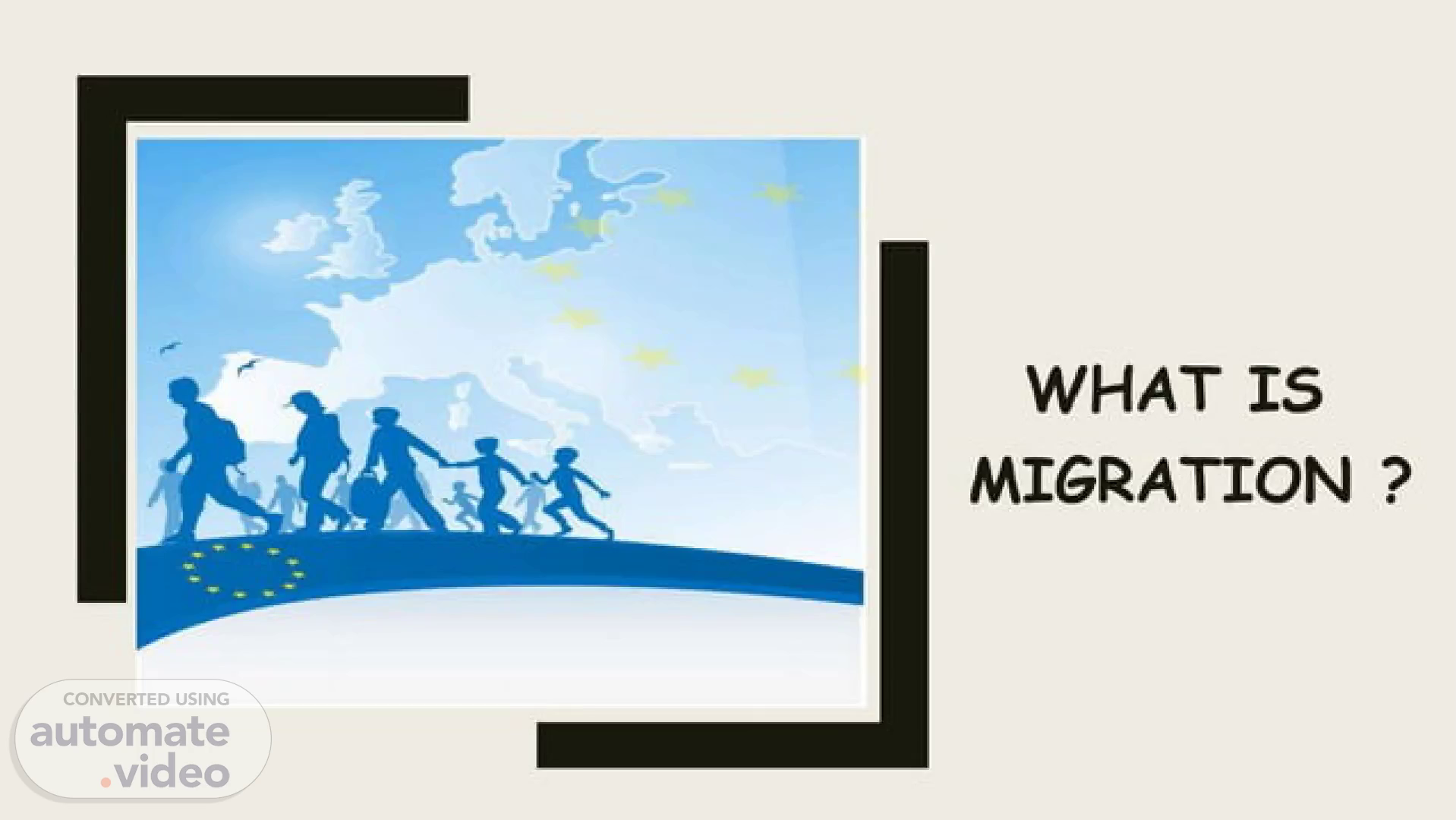Scene 1 (0s)
WHAT Is MIGRATION ?.
Scene 2 (6s)
MIGRATION •means crossing the boundary of political or administration unit for a certain minimum period -It refers to the movement from one region or country. MAJOR TYPES OF MIGRATION Intemal Migration Refers to the movement from one area (a province, district Ot municipality) to another within a country. It spans great distances and bring together very different people. International Mig ration is a term used to refer to change Of usual residence between nations,.
Scene 3 (25s)
Categories of International Migrants Tem porary Labor Migrants (also known as guest workers or overseas contract workers). This refers to men and women who migrate fora limited period in order to take up employment and send money homm Hiqhly skilled and Business Migrants— people with qualifications as managers, executives, professionals, teatmcians or similar, who move within internal labor markets of transnational corporations and international organizations or who seek employment through international labor markets for scarce skills. Irregular Migrants These are the people who enter a country, usually in search of employments, without the necessary documents and permits. Refugees— is a person residing outside his or her country of nationality, who is unable or unwilling to return because of a *well-founded fear of persecution on account of race, religion, nationality, membership in a particular social or political opinion Asylum seekers— people who move across borders in search of protection, but who may not fulfill the stryct criteria lay down by the Convention- Forced Migration —this includes not only refugees and asylum seekers but also people forced to move by environmental catastrophes or development projects. Family Members —falso known as family reunion or fam ily reunification mig rants}. This refers to migration to join people who have already entered in immigration country under one of the above categories, Return Migrants—these are the people who return to their countries oforigin after a lonq period io another country. They are often looked favorably as they may bring with them capital, skills, and experience useful for economic development..
Scene 4 (1m 23s)
CAUSES OF MIGRATION International migration is an integral part of globalization. The key tool is modern communication technology. including internet, improved telephone connection and cheap air travel. The following are the CAUSES OF Disparity Of income, employment , and social well•being Differences on demographic patterns with regards to fertility Rapid increase in cross-border flows A catastrophe (such as war or environmental degradation) Migrations may lead to international communicative netwatkse which affect economic relations, social and political institutions..
Scene 5 (1m 44s)
NOIXVU91W IV8019 go SQNäU IVOIWXSIH 21-1-1-.
Scene 6 (1m 51s)
Human Migration : 19th century.
Scene 7 (1m 57s)
AMERICA AUSTRALIA OCENIA NORTHERN ASIA AFRICA WERE COLONIZED BY EUROPEAN MIGRANTS.
Scene 8 (2m 4s)
MIGRATION BEGAN INTHE : IRELAND & GERMANY (1840) EASTERN & SOUTHERN EUROPE (1880'S) UNITED STATES (1880-1910).
Scene 9 (2m 12s)
MIGRATION AND DEVELOPMEN growth of rot•on involves a transfer Of the most valuable economic resource. human capital „enCourage ernegration for employment Philippines has set up the OverseasW0fkers Welfare Administration (OWWA} in 1997. which provides a tange Of services, including pre•departure orientation seminars and special officials at consulates to assi5t migrant5 (Tomas, 1999),.
Scene 10 (2m 27s)
SETTLEMENT AND DIVERSITY MIGRATION LEADS TO SETTLEMENT, WHO CAME FROM DIFFERENT TYPES OF SOCIETIES WITH DIFFERENT TRADITIONS, RELIGIONS, POLITICAL INSTITUTIONS, LANGUAGES AND VISIBLY DIFFER IN PHYSICAL APPEARANCE..
Scene 11 (2m 39s)
Migration as a Challenge to the Nation State Migration and ethnic diversity threaten such ideas of the Nation} create people without common ethnic origins. *Economic Development *Crisis of Confidence *Safety and security *Difficult to sustain homogeneous Nation.
Scene 12 (2m 50s)
Five Aspects to identify: *The hmited impact of government's and State Controß • state witl not be able to control and manage directly migration flow, *Remittances tong term socio-economic and political factors 5tronge5t foreign investment worldwide... IMMIGRANTS *Double identities-Double Loyalties *Brain drain or Brain gain- brain drain from developing to the developed countries 4 • The Challenge of Transnational Criminal and Terrorist Networks • distinguish harmless person from harmful norm violation..
